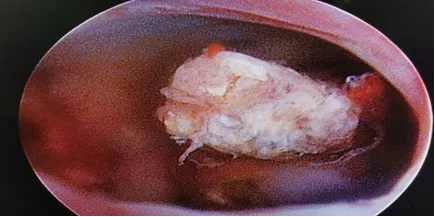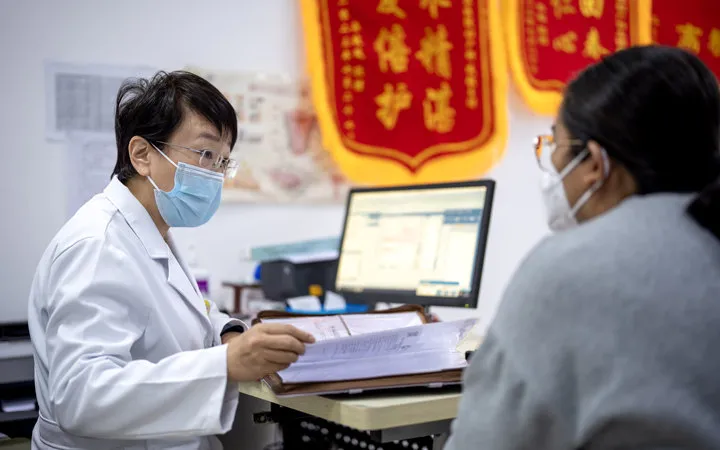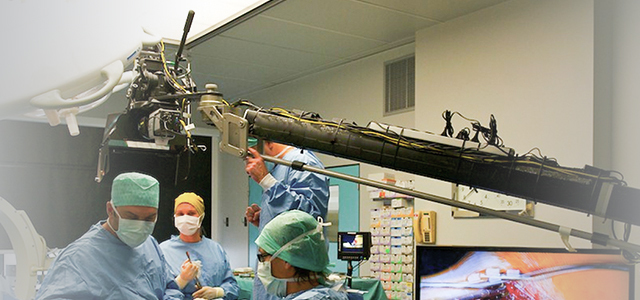Zhejiang University Run Run Shaw Alar Hospital’s "Uterine Defense Battle"
Recently, an acquaintance with a worried face was received at the Obstetrics and Gynecology Clinic of Run Run Run Shaw Alar Hospital of Zhejiang University. The patient had an unexpected pregnancy and a medication abortion, and continued to have a small amount of vaginal bleeding for more than a month before coming back for follow-up. During the ultrasound examination, Director Wang Bo and Director Xu Haishan of the Ultrasound Medicine Department immediately issued an "alarm": residual intrauterine pregnancy tissue accompanied by the formation of arteriovenous fistula. A slightly higher echogenicity of 3.2x2.5x2.8 cm can be seen in the uterine cavity, with rich blood flow signals visible in the surrounding and internal areas. PW can measure the frequency spectrum of the arteriovenous system.
After receiving the alarm, the director of gynecology, Liu Zhaohong, carefully inquired about her medical history and reviewed her previous medical records. She found that three months ago, the patient sought medical attention at the hospital due to "incomplete miscarriage combined with uterine arteriovenous fistula and vaginal bleeding". She underwent emergency uterine artery embolization and hysteroscopic residual tissue resection of pregnancy. The patient experienced residual intrauterine pregnancy tissue with arteriovenous fistula again, and the PSV was as high as 108 cm/s, RI: 0.28; Uncontrollable vaginal bleeding may occur at any time;

01 Best Plan
Director Liu Zhaohong promptly contacted the hospital’s specially appointed director of obstetrics and gynecology, Xu Wenzhi, and general practitioners to discuss difficult cases within the department. He conducted meticulous research on the development of treatment plans, considering that patients are young and have fertility requirements. If uterine artery embolization is performed again in a short period of time, it may cause ovarian dysfunction, which may affect the patient’s fertility and quality of life.
After thorough communication and discussion between the gynecology and ultrasound medical departments, it has been decided to perform minimally invasive ultrasound-guided radiofrequency ablation of the uterine arteriovenous fistula for the patient first, in order to eliminate the lesion of the arteriovenous fistula and reduce the risk of life-threatening vaginal bleeding, while not affecting ovarian function and maximizing fertility protection. After closely observing the condition and waiting for the postoperative blood HCG to return to normal, a hysteroscopic removal of residual uterine pregnancy tissue was performed at an appropriate time. The patient and their family members were fully informed of the possible adverse consequences of uterine arteriovenous fistula and the current diagnosis and treatment plan, and their eyebrows finally relaxed.
02 Surgery went smoothly

After more than a month of radiofrequency ablation of the uterine arteriovenous fistula, the patient’s blood HCG decreased to normal. A follow-up ultrasound showed no blood flow signal around the residual tissue in the uterine cavity. In early May, hysteroscopy was performed again on the patient. During the surgery, it was found that the uterine cavity was about 8 cm deep, and multiple dark red residual pregnancy tissues were visible in the uterine cavity. The remaining areas of the endometrium were thin, and bilateral fallopian tube openings were visible. After using the planing system to process the residual tissue, the uterine cavity had a regular shape, and intraoperative bleeding was 5 ml. The surgery was successful.
03 Sincere thanks
On the second day after surgery, the patient had no vaginal bleeding and was safely discharged. The patient exclaimed excitedly, "Thank you, Director Liu, for always taking care of our patients and treating us like family members, preserving both my uterus and protecting my ovaries. I sincerely thank all the medical staff in the gynecology department of Run Run Run Shaw Alar Hospital, Zhejiang University!"
04 Everything for the patient

"Our gynecological team has always pursued the goal of actively promoting new technologies, conducting new businesses, and promoting interdisciplinary collaborative treatment models, demonstrating our hospital’s professional treatment capabilities, and pursuing excellence in technology to serve the vast number of patients, which is not as good as the reputation of the common people." Director Liu Zhaohong said.
05 Science popularization related to uterine arteriovenous fistula
Uterine arteriovenous fistula is divided into two categories: congenital and acquired. Congenital uterine arteriovenous fistula is very rare; Acquired uterine arteriovenous fistula is more common and is generally related to miscarriage, childbirth, curettage, etc; Its main clinical manifestations are: vaginal bleeding, lower abdominal pain, secondary anemia, etc; It can also lead to uncontrollable massive bleeding in a short period of time, risking the loss of the uterus and life; Uterine arteriovenous fistula usually refers to the formation of a communicating branch between veins and arteries. Due to the connection between the uterine arteries and veins, and the formation of a rupture between the two, arterial and venous blood can communicate with each other. This disease is usually divided into two categories: congenital and acquired; Congenital uterine arteriovenous fistula is very rare; Acquired uterine arteriovenous fistula is often secondary to surgical procedures or uterine trauma, such as miscarriage, curettage, delivery, etc. Some rare cases of acquired uterine arteriovenous fistula can be caused by infections, trophoblastic diseases, endometrial cancer, and cervical cancer. The symptoms of uterine arteriovenous fistula usually include sudden vaginal bleeding, pale complexion, coagulation dysfunction, etc. This type of bleeding is different from normal menstruation, often occurring without warning, suddenly, and even uncontrollable massive bleeding in a very short period of time, risking the loss of the uterus and life.
Director Liu Zhaohong reminds female friends to scientifically regulate contraception, avoid unplanned pregnancies, and reduce the damage to the uterus caused by short-term and long-term complications caused by induced abortion. The commonly used contraceptive methods include the following: 1. Condom: a safe, simple, and effective contraceptive tool. At the same time, it can effectively prevent sexually transmitted diseases, such as gonorrhea, syphilis, AIDS, etc; During use, it is important to choose the appropriate model and check for any damage before use. Use throughout sexual activity; 2. Intrauterine device: a safe, convenient, effective, economical, and reversible contraceptive tool; The type and duration of placement of intrauterine devices vary, generally ranging from 5 to 20 years; Reminder: IUDs must be removed after their expiration date; 3. Short acting oral contraceptives: safe and effective; Before use, it is necessary to consult a professional physician to rule out contraindications to oral short acting contraceptives; 4. Subcutaneous implant: can be placed within 7 days of the start of the menstrual cycle, placed on the subcutaneous inner side of the left upper arm with minimal side effects, and placed for 3 years; 5. Sterilization surgery includes tubal ligation and vas deferens ligation: once and for all, with no side effects.
Unreliable contraceptive methods: 1. Extracorporeal ejaculation: failure rate as high as 27%. 2. Safe period contraception: Physical condition, emotions, diet, etc. can interfere with ovulation, so safe period contraception is very unsafe, with a failure rate as high as 25%. 3. Emergency contraception: It is a remedial measure and cannot be used as a routine contraceptive method. The winning rate (accidental pregnancy) has greatly increased
Overall, uterine arteriovenous fistula is a serious gynecological disease that requires timely diagnosis and treatment. Female friends should use scientific and standardized contraception to avoid unexpected pregnancies. After a miscarriage, they need to undergo regular check ups according to medical advice. When abnormal situations occur, medical assistance should be sought immediately to prevent further disease progression.
This article is reprinted from "Dingxiangyuan"
Surgerycast
Shanghai Headquarter
Address: Room 201, 2121 Hongmei South Road, Minhang District, Shanghai
Tel: 400-888-5088
Email: surgerycast@qtct.com.cn
Beijing Office
Address: room 709, No.8, Qihang international phase III, No.16, Chenguang East Road, Fangshan District, Beijing
Tel: 13331082638( Liu )
Guangzhou Office
Address: No. 15, Longrui street, longguicheng, Taihe Town, Baiyun District, Guangzhou
Tel: 13302302667 ( Ding )






